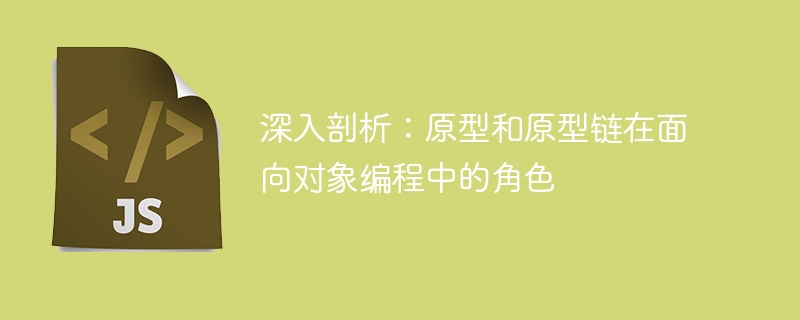

In-depth analysis: The role of prototype and prototype chain in object-oriented programming, specific code examples are needed
In object-oriented programming (OOP), prototype (Prototype) and prototype chain (Prototype Chain) are important concepts. They provide an object-based code reuse mechanism and play a key role in languages such as Javascript. In this article, we'll take a deep dive into the concepts of prototypes and prototype chains, explore their role in OOP, and illustrate with concrete code examples.
__proto__ attribute. When we access a property or method of an object, if the object itself does not have one, it will be looked up through the prototype chain until the end of the prototype chain. Sample code:
// 创建一个原型对象
const personPrototype = {
greet: function() {
console.log(`Hello, my name is ${this.name}`);
}
};
// 创建一个对象并设置原型
const person = Object.create(personPrototype);
person.name = "John";
person.greet(); // 输出: "Hello, my name is John" In the above code, we create a prototype object personPrototype which has a greet method. Then, we created a new object person through the Object.create() method and set personPrototype to its prototype. Next, we added a name attribute to the person object, and then called the greet method, successfully accessing the method of the prototype object.
Object.prototype). This can realize the inheritance of properties and methods and improve the reusability of code. Sample code:
// 创建一个原型对象
const animalPrototype = {
eat: function() {
console.log("Eating...");
}
};
// 创建一个对象并设置原型
const dog = Object.create(animalPrototype);
dog.bark = function() {
console.log("Barking...");
};
dog.eat(); // 输出: "Eating..."
dog.bark(); // 输出: "Barking..."In the above code, we create a prototype object animalPrototype, which defines an eat method. Then, we created a new object dog through the Object.create() method and set animalPrototype to its prototype. Next, we added a bark method to the dog object. When we call the eat method of the dog object, the method is successfully found on the prototype chain. Similarly, when we call the bark method of the dog object, since the bark method is defined on the dog object itself, it is called directly .
(1) Code reuse: Through prototypes and prototype chains, we can realize the sharing of properties and methods, avoiding the need to Repeatedly define the same code to improve code reusability.
(2) Inheritance: Through the prototype chain, the inheritance relationship between objects is realized. Child objects can inherit the properties and methods of the parent object, and can achieve personalized customization through rewriting.
(3) Dynamics: Prototype objects can dynamically add or modify properties and methods, and all corresponding objects can obtain updated content in real time without the need to modify them individually.
For most object-oriented programming languages, prototypes and prototype chains are basic and important concepts. Through them, we can organize and manage code more effectively and improve the maintainability and scalability of code.
Summary:
In this article, we provide an in-depth analysis of the role of prototypes and prototype chains in object-oriented programming. A prototype is an object that can share properties and methods. The prototype chain is an upward search mechanism through which properties and methods can be inherited. We demonstrate the use of prototypes and prototype chains with concrete code examples and explore their benefits. Understanding and being familiar with the concepts of prototypes and prototype chains is very important for understanding and applying object-oriented programming.
The above is the detailed content of In-depth discussion: Analysis of the role of prototypes and prototype chains in object-oriented programming. For more information, please follow other related articles on the PHP Chinese website!




